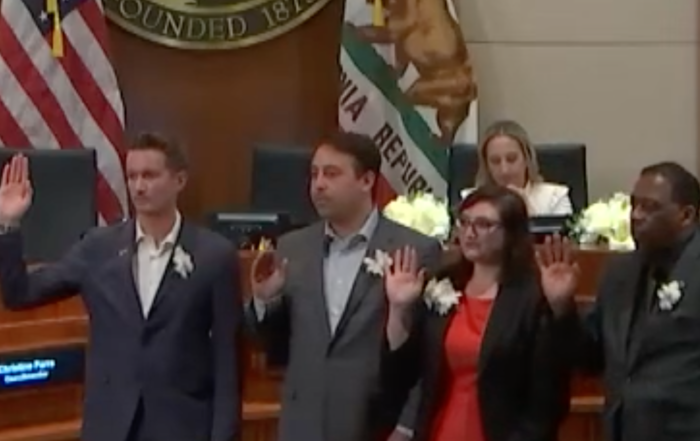Last week, the Santa Monica City Attorney’s Office sponsored a symposium on the history of Fair Housing policy both locally and in California. The Federal Fair Housing Act is celebrating its 55th anniversary this month, having passed in 1968.
Mayor Gleam Davis was on hand with opening remarks, saying “It’s important to remember that there was a time where we didn’t think Fair Housing was a right; where it wasn’t codified into law. And while it’s easy to take for granted that the law was passed in 1968, I think you’ll hear today that it’s a battle we confront on virtually a daily basis.”
“It’s unusual for a city our size to have this number of lawyers and staff dedicated to housing issues. There is nothing in the city that we take more seriously than housing issues,” added City Attorney Doug Sloan, speaking to the city’s dedication to equitable and fair housing.
The event brought back to Santa Monica Adam Radinsky, who for 22 years led the Consumer Protection Division of the Santa Monica City Attorney’s Office. Radinsky, who is now Special Counsel to the Alameda City Attorney’s Office, along with Tony Tolbert, the Assistant Director of Admissions for the UCLA School of Law, emceed the remainder of the symposium. Through the presentations of several presenters, several shocking revelations emerged in the discussion.
Facebook Advertising Lawsuit
Jacy Gaige, Director of the Compliance and Disability Rights Division in the Office of Fair Housing and Equal Opportunity at the Department of Housing and Urban Development (HUD), recently settled a case against Facebook for their discriminatory advertising practices around housing. She presented some findings about how big data and the algorithms that generate it have a huge impact on who is able to find housing opportunities, receives financing and on what terms, is approved for rental housing, and even who has their homes approved at higher values than others.
She spoke of “machine-driven decision-making” algorithms as being presented to the public as something that will ignore human-driven biases in decision-making. But in fact, algorithms learn and practice bias too. Why? Because, Gaige explains, the artificial intelligence (AI) running algorithms draw from decades of data tainted with bias and discrimination. And historically, the data is telling algorithms a story of an America where certain people can live and work and interact with others in certain places, while others do all of these things in different places. The AI doesn’t know those years were wrong and unjust, so they accept the discriminatory data as the way things should be, perpetuating the problem.
“Unless addressed, discrimination is going to persist no matter how sophisticated the system, or, sometimes, because of the sophistication of the system,” said Gaige.
The investigation into Facebook’s housing-based advertising took place in 2018-2019 before being turned over to the U.S. Department of Justice (DOJ) for litigation. It settled in January of this year.
Through Facebook partner sites, which Gaige says number in the hundreds of thousands, Gaige explained we still see Facebook-generated ads on numerous sites and apps that aren’t Facebook. “Everyone in this room has seen Facebook ads – and not a few – a lot,” she said. She then identified three main ways Facebook ads were taken to task:
- Explicit categories of traits and interests that advertisers can select from, and are apparently very granular and into the thousands. In the past, Gaige said, an ad could be targeted to “all renters in Santa Monica that aren’t parents.” But Facebook had also been allowing advertisers to add exclusions, like ‘except for Blacks, Latinos, Asian-Americans, Muslims, Jews, handicapped persons,’ and dozens more
- The Ad Delivery System, or what the DOJ calls “the Ad Personalization Algorithm. Gaige said this is the system by which Facebook selects who will actually view the ad. She said if an advertiser wanted to show an ad for housing only to “Professionals in Santa Monica making over $200,000 a year,” this system will not, in fact, show it to everyone meeting that demographic. She says that would likely overload Facebook users’ feeds with ads. Instead, she says, “They show it to a subset – and it’s not a random sub-set – that Facebook has predicted are most likely to engage with the ad in a selective way.” She says Facebook themselves say they use “age, gender, language, purchase behaviors (on and offline), interests, activities, pages liked, where you live, the places you like to go, the businesses and people you are near, among other things, to show you [the user] the ads most pertinent to you.”
- The Look-Alike Function used by Facebook. Facebook essentially uses this algorithm to find users who are similar in demographics, interests, and behavioral patterns. The obvious problem here is, it’s already favoring white, Christian audiences in the selection of the first group of users, and thus the “Look-Alikes” are going to be the same.
How do these actions violate the Fair Housing Act? Gaige says they violate a clause that states, “Making dwellings unavailable to persons because of their protected characteristic,” and another that states, “Making, printing, publishing, or causing to be made, printed, or published, housing ads that indicate a preference, limitation, or discrimination based on a protected characteristic.”
So what did Meta – Facebook’s parent company – agree it would do in the legal settlement?
- To no longer provide targeting options to housing advertisers that directly describe or pertain to protected characteristics
- To stop using the “Look-Alike” tool with housing advertisers
- Develop a new system for housing ads to “address disparities in delivery”
In December, DOJ affirmed it was satisfied that the site had addressed disparities in the delivery of housing ads, allowing for the settlement to close in January.
History of Local Racist Policies in Housing
Chancela Al-Mansour also participated in the symposium. She serves as Executive Director of the Housing Rights Center (HRC), which, among other things, donated more than $300 Million in rental assistance to more than 70,000 households during the height of the COVID pandemic. The organization has become a primary source of legal defense for renters and homelessness prevention.
Al-Mansour spoke of institutional racism in housing policy here in Southern California, saying, “We had government-mandated segregation – yes, in Los Angeles – neighborhoods were segregated by law. We had sundown laws; many cities, including Santa Monica, Glendale, and South Pasadena, had sundown laws where, if you were Black, you had to be outside city limits by sundown.” Black residents weren’t allowed to own property and were subject to predatory lending practices.
She also spent time discussing Redlining, the horrific practice of color-coding neighborhoods within cities where Black residents were essentially allowed to live, and where they distinctly were not. When the home mortgage program was established as part of Roosevelt’s New Deal, it was really only intended for white Americans, Al-Mansour explained. If you lived within a redlined neighborhood, you could not get a mortgage or a home improvement loan.
Black and Latino residents were also subject to violence and harassment. She informed the audience that the Ku Klux Klan (KKK) had a headquarters in Glendale for many years and that many members of Glendale’s city council were members. So too, she said, were many members of other smaller cities in L.A. County. Black neighborhoods were also denied many basic services like running water and sidewalks. They also lacked code enforcement services, leaving them in sub-par and often unsafe housing conditions.
Al-Mansour also spoke about a more recent case up in Marin County where a Black couple had their home re-appraised and found the appraisal far below other comparable houses in their area. So they “white-washed” their property, taking out any semblances of Black culture or personal photographs and even had white friends come place their photos up in the home. When they had the property re-appraised yet again, it was appraised for almost $500,000 more.
She also revealed a shocking detail about California state history for which Westside Voice was patently unaware: slavery occurred here, and more recently than we would think. Despite the State Constitution stating, “Neither slavery nor involuntary servitude shall ever be tolerated in this state,” she says that an estimated 1,500 Black slaves were brought to California in the 1950s for mining purposes and involuntary servitude and that the count was probably a lowball estimate.
Al-Mansour showed examples of ads for then new and growing communities like Leimert Park, which decades ago while being built ran ads boasting of how “restricted” the development planned to be. She also reminded the audience that Japanese-American families were removed from their homes in L.A. (including many in Leimert Park) when the U.S. declared war on Japan in World War II.
Black Angelenos weren’t the only residents affected of course. She also went a little bit into the troubling history of Chavez Ravine, where Dodger Stadium now sits, and the fact that it was once a thriving Latino community with schools, its own post office, and other amenities. But the L.A. Housing Department along with the city’s mayor at the time came up with a plan to rid the area of the predominantly Mexican-American families with the guise that they were going to build a lot of multi-family housing. What began as buy-outs turned into forced evictions of the last hold-outs who didn’t want to leave. And, of course, we all know the housing was never built, but was a ruse to move these families out. The Dodgers played no role in this horrendous policy, but they certainly were the beneficiary.
Mr. Radinsky and Mr. Tolbert capped the event with a presentation on Reparations for minority communities, but unfortunately, Westside Voice was not able to stay to hear it. We are awaiting their presentation to be sent and will add to the story at that time.
Photo by Andrii Yalanskyi
Stay informed. Sign up for The Westside Voice Newsletter
By clicking submit, you agree to share your email address with Westside Voice. We do not sell or share your information with anyone.








